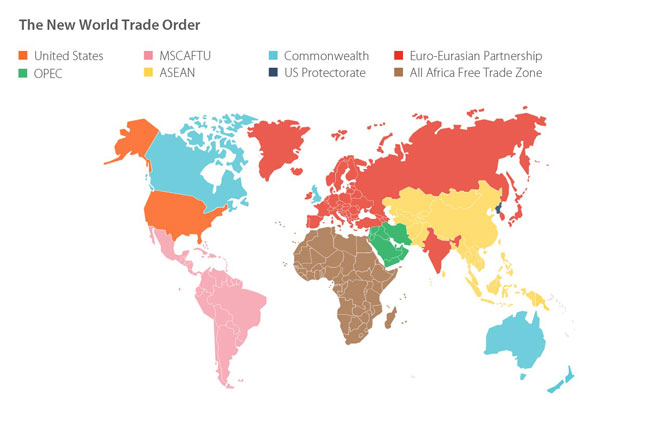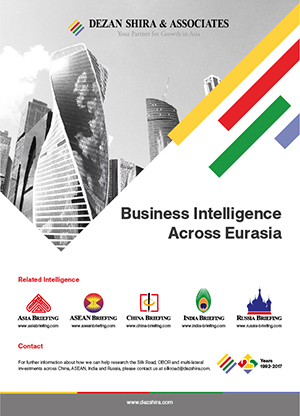After Trump, Putin and Xi – How the New World Trade Order Will Look in 2030

The past few days and weeks have been fairly monumental in illustrating that a new world order and trade relationship pattern is emerging. While China and to some extent, Russia, have been carrying this out, albeit with soft power overtones with the emergence of the Belt and Road Initiative and the Eurasian Economic Union, the United States has taken a rather more aggressive path in dismantling existing trade agreements and partnerships.
That Donald Trump has been seen to be so assertive should be no surprise, he is not a career politician, although he has taken a fairly low-key initial 12 months to meet and assess his global partners, the character and belligerence that has seen him survive six corporate bankruptcies has begun to emerge. Increasingly, his political speak has turned to business talk – everything is a “deal” and is negotiable.
In some cases, such as the meeting with Kim Jong-Un, this is a positive. While some politicians regret seeing the North Korean leader displayed as “if having the same status as the United States President” the reality is that at least the two sides are now talking. The last decade of Washington’s attitude towards the DPRK has seen a worsening of relations and the nuclearization of the Korean Peninsula. In short, the previous United States policy towards Pyongyang had clearly failed. Trump’s attitude towards Kim is a much needed strategic change that something new needs to be tried, and all credit to him for trying to pull it off. Later weeks and months will show how effective this has been.
I am less sure of his position concerning trade, and the wisdom of his pulling out of deals and antagonizing existing trade partners. The Guardian newspaper has produced an interesting article titled “Trump was right, the rest of the G7 were wrong” which brings up the old issue of trade agreements being conducted and signed off without any public referendum. That does ignore the fact that the governments signing these off, if democratic, were legitimately elected to sort out such stuff so we don’t have too. Trade is a two-way street, or should be, and businesses need sustainability or at least some degree of predictability in order to plan, invest, and provide for increasing numbers of people on the planet. The real issue with old America up to Trump is that it saw that as a global responsibility, and would adjust and compromise, and Trump sees his as an American responsibility and wants the best deal for the United States. To that end, we may well see the US pulling out of global trade deals, with Trump already on record as suggesting the United States may pull out of the WTO altogether. That would mean the end of NAFTA and possibly the G7 as well as the TPP Trump has already dismissed. Instead, the United States would commit to a series of bilateral rather than multilateral deals, effectively leaving it as a trade bloc on its own.
In which case, a future new trade world structure could look something like this.

The reasoning behind the map is as follows:
The United States (orange)
It has pulled out of all global trade partnerships, and from its position as an economic superpower, is essentially self-sufficient. In areas where it is not, it agrees to bilateral deals with countries on an as-need basis. In such a manner, it is able to reward or punish countries on a case by case basis rather than have to deal with multilateral agreements. This position also allows it to influence other trade blocs without having to deal with them directly. As a result, all other member bloc internal mechanisms allow for a unified approach but permit individual dialogue only with the US. Blocs whose members deal with the US over trade then ban the movement of American-made products across their borders.
The US maintains a footprint in Asia with a heavily US invested North Korea, which becomes the new US ally in Asia and is used to monitor China. Pyongyang develops as a regional offshore financial center and an alternative to Hong Kong as a result.
North Korea (dark blue)
The DPRK maintains its sovereignty, however, becomes a defacto offshore financial center with an open free trade policy, supported by the United States. Delaware and Nevada corporations are first encouraged, then told to move their operations out of the United States mainland and to the DPRK, which becomes a magnet for offshore banking, law and tax firms, rivaling Hong Kong and Singapore.
The Euro-Eurasian Partnership (red)
The EU fails to secure deals with the United States, and has lost the UK too. Maintaining the legitimacy of the Euro becomes too heavy a burden for Germany and France to fund, and the EU instead starts to take Russia’s lead in looking East. After agreeing to significant use of both the Euro, Ruble, and RMB Yuan in trade, both Beijing and Moscow step in to support the Euro and diminish their trade reliance on the US dollar as a result. After several years of being an observer and dialogue partner to the Eurasian Economic Union, a Free Trade Agreement is signed. Increasing Chinese investment into Europe, and the rise of the Chinese, Indian, and Russian middle class consumer base sees elements of the EU, EAEU, other parts of Asia, India, Pakistan, and the Belt and Road Initiative merge into a new entity known as the Euro-Eurasian Partnership. The Presidency of this revolves every two years between Beijing, Berlin, Brussels, Delhi and Moscow, with other Eurasian cites revolving every five years. It signs a free trade agreement with ASEAN, and limited deals with the Commonwealth, OPEC, and the All-Africa Free Trade Zone. Neither China nor Russia have individual agreements with the US, but Georgia, Turkey, Bulgaria, and Romania do. This allows US activities in the Black Sea, while Israel and Lebanon have US FTAs allowing the US access to international waters in the Mediterranean. The Euro-Eurasian Partnership often complains about US warships escorting commercial shipping through these routes. Potential conflict and sanctions begins between the US and the Euro-Eurasian Partnership over warship exercises being held in what the US terms as international waters while Chinese, Russian, and European shipping is passing through the Arctic Northern Sea Passage. The US also complains about military build ups on islands in the Black Sea, Cyprus, Krk, and Malta.
ASEAN (yellow)
ASEAN expands to include the rest of south-east Asia and maintains an FTA with the Euro-Eurasian Partnership, the Commonwealth, and limited FTA with the All Africa Free Trade Zone and the Mexico, South and Central American Free Trade Union. Half of the ASEAN members, including Vietnam, Malaysia, Thailand, and Singapore have individual agreements with the United States.
All African Free Trade Zone (brown)
The AAFTZ is born from the success of the regional African digital FTA, and has a revolving two year Presidency including Cairo, Lagos, Nairobi, and Cape Town. Other African cities are rotated every five years. African immigrant workers become a common sight in the Euro-Eurasian Partnership. It signs a limited FTA with the Euro-Eurasian Partnership, ASEAN, the Commonwealth, OPEC, and MSCAFTU.
The Commonwealth (light blue)
A post-Brexit United Kingdom links up with its allies Canada, recently divorced from NAFTA, Australia, and New Zealand. King William is the presiding Head, with Presidency revolving between Auckland, Canberra, London, and Quebec. It signs a limited FTA with the Euro-Eurasian Partnership, AAFTZ, OPEC, and MSCA. All members have separate agreements with the United States.
Mexico, South, and Central American Free Trade Union (pink)
With Mexico left out of NAFTA and a wall built across the border with the United States, Mexico looks to the south and engages with Mercosur and the other Central and South American countries to form the MSCAFTU. Presidency is rotated between Mexico City, Sao Paolo, Santiago, and Caracas with the other Central and South American cities being included for rotation once every five years. It signs a limited FTA with the All African Free Trade Zone and ASEAN.
OPEC (green)
OPEC consolidates its position as being centered on the Middle-East and evolves into a Free Trade Zone. It signs an FTA with the Euro-Eurasian Partnership, has partial FTA with all other major blocs and most members also have individual agreements with the United States.
The impact of this sees global power shift away from Washington and towards Beijing, Delhi, and Moscow. This follows the demographic rise of China, which as we have seen has emerged as a major power built on a huge population. The Euro-Eurasia Partnership consequently boasts the largest concentration of wealth on the planet. The US maintains its position but with less influence, although growth is moderate and it remains sustainable. It is often accused of meddling in other Partnerships affairs, while all foreign nationals must apply for US visas six months in advance.
The fastest global growth area is now the All Africa Free Trade Zone, where again, population demographics are seeing massive investment into cheap labor and mass-produced goods. “Made in Africa” is now supplanting “Made in India” as it too had supplanted “Made in China”.
The Commonwealth, like the US, is experiencing moderate growth, although Canada and Australia now earn more than the United Kingdom. There are tensions with London as political elements lobby to join the Euro-Eurasian Partnership. The “Pro-Eurasia Party” replaces the Liberals as the third political force in the UK.
OPEC continue to drive global oil and gas prices, but as a region are fairly closed off towards foreign investment, which must follow strict Islamic laws. It does, however, enjoy an excellent relationship with the US. The Mexico, Central, and South America Free Trade Union is beset by infighting, although Mexico City has evolved as the regional power.
Globally, there are calls to reconvene the “new” G7 – Brazil, China, India, Iran, Mexico, Nigeria, and Russia.
Comments are welcome.
About Us
Chris Devonshire-Ellis is the Founding Partner of Dezan Shira & Associates, Publisher of Asia Briefing and visiting lecturer at Russia’s Higher School of Economics. He is often interviewed in international media on matters of Asian development strategy and is well known as a Belt & Road academic. He may be contacted at chris@dezshira.com.
 Related Reading:
Related Reading:
![]() A Brave New World: China, Russia, and ASEAN Lead Eurasian Free Trade
A Brave New World: China, Russia, and ASEAN Lead Eurasian Free Trade
![]() Trump Out, Xi and Putin In – China, Russia Want Asia-Pacific Free Trade Deal
Trump Out, Xi and Putin In – China, Russia Want Asia-Pacific Free Trade Deal
![]() China and Russia’s Strategy to End US Dollar Trade Dominance
China and Russia’s Strategy to End US Dollar Trade Dominance
Silk Road and OBOR Business Intelligence
Dezan Shira & Associates´ Silk Road and OBOR investment brochure offers an introduction to the region and an overview of the services provided by the firm. It is Dezan Shira´s mission to guide investors through the Silk Road´s complex regulatory environment and assist with all aspects of establishing, maintaining and growing business operations in the region.






